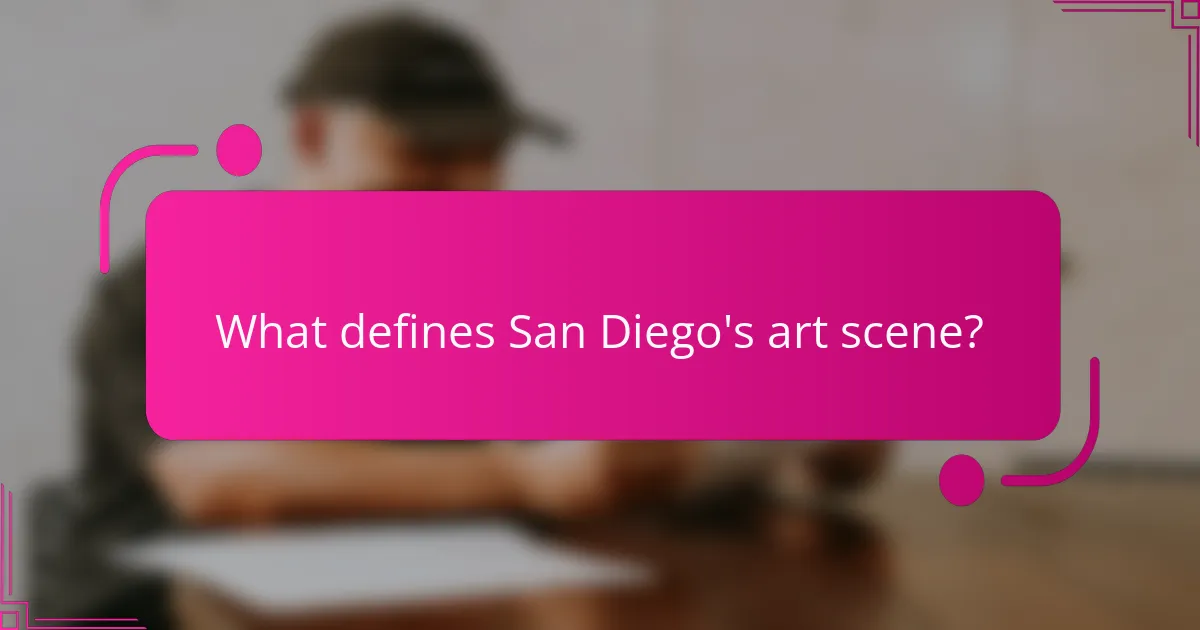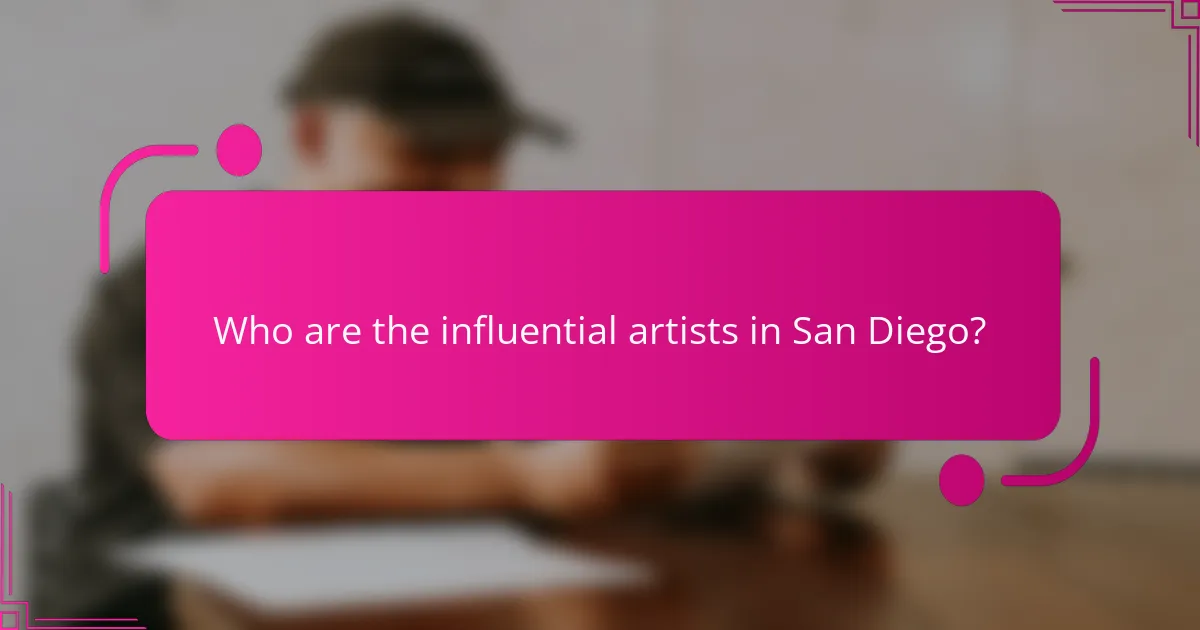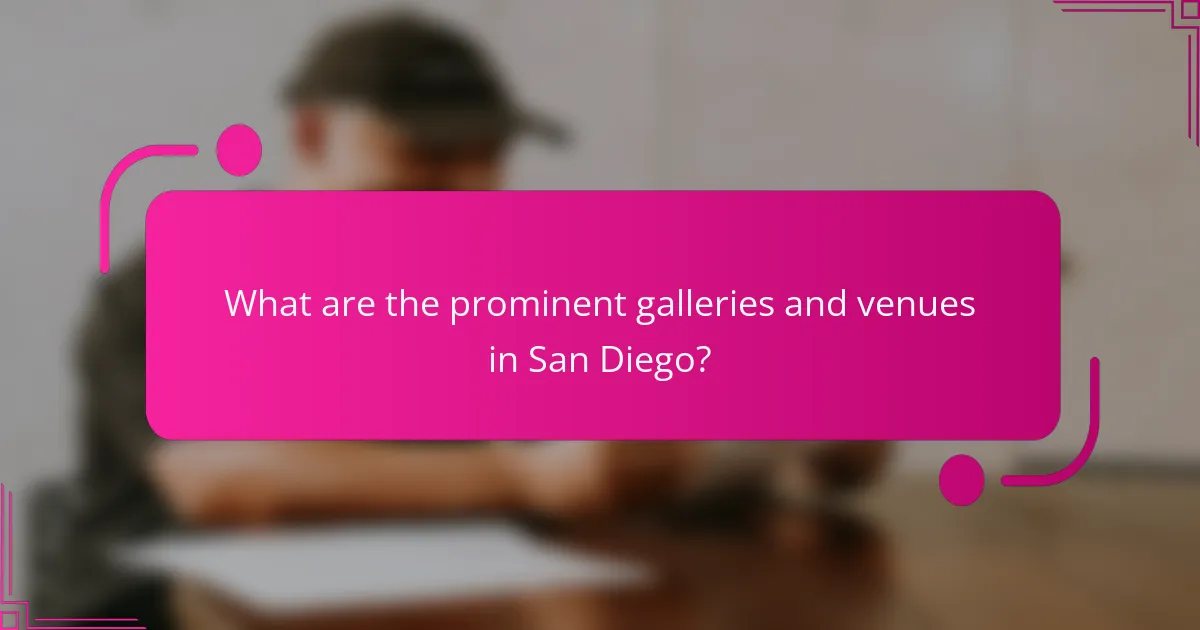
What defines San Diego’s art scene?
San Diego’s art scene is defined by its diverse artistic expressions and vibrant cultural landscape. The city features numerous galleries, museums, and public art installations. Notable institutions include the San Diego Museum of Art and the Museum of Contemporary Art San Diego. The annual Comic-Con International highlights the city’s role in pop culture art. Local artists contribute to a rich tapestry of murals and street art throughout neighborhoods. Events like Art Walk showcase emerging talent and foster community engagement. San Diego’s unique blend of coastal influences and multicultural heritage shapes its artistic identity. The city’s art scene continues to evolve with ongoing support for creative initiatives and collaborations.
How has San Diego’s art scene evolved over the years?
San Diego’s art scene has evolved significantly over the years. Initially, it was characterized by traditional forms of art and local artists. In the 1960s and 1970s, a shift occurred with the introduction of more contemporary styles. The establishment of institutions like the Museum of Contemporary Art San Diego in 1941 fostered this change. The 1980s and 1990s saw the rise of street art and murals, reflecting social issues and community identity. In recent years, the art scene has embraced digital and multimedia art forms. Events like Art San Diego and the annual San Diego Art Walk have increased visibility for local artists. Today, the art scene is diverse and inclusive, showcasing a wide range of cultural influences. This evolution mirrors broader societal changes and the city’s growing population.
What historical events have influenced the development of art in San Diego?
The development of art in San Diego has been influenced by several historical events. The establishment of the San Diego Mission in 1769 marked the beginning of cultural exchange. The California Gold Rush in the mid-1800s attracted artists and settlers, boosting local art scenes. The Exposition of 1915 showcased regional talent and introduced new artistic movements. The post-World War II era saw an influx of artists, contributing to diverse artistic expressions. The establishment of institutions like the San Diego Museum of Art in 1926 further supported local artists. Additionally, the Chicano Movement in the 1970s emphasized cultural identity through art. Each of these events played a critical role in shaping San Diego’s vibrant art community.
How do local demographics shape the art community?
Local demographics significantly shape the art community by influencing the types of art produced and the audiences that engage with it. Diverse populations contribute varied cultural perspectives, resulting in a rich tapestry of artistic expression. For example, San Diego’s large Hispanic community fosters art that reflects Latino heritage and themes. Additionally, age demographics impact art trends; younger populations often gravitate towards contemporary styles, while older generations may prefer traditional forms. Economic factors also play a role; affluent areas may support high-end galleries, while lower-income neighborhoods might see more grassroots art initiatives. Studies show that cities with diverse demographics have more vibrant and varied art scenes, as seen in San Diego’s community art projects that engage residents from different backgrounds. This interplay between demographics and art creates a dynamic environment that continuously evolves.
What are the key characteristics of San Diego’s art scene?
San Diego’s art scene is characterized by its diverse artistic expressions and vibrant cultural landscape. The city features a mix of contemporary and traditional art forms. Numerous galleries showcase local and international artists. Events like Art Walk and Comic-Con highlight the community’s engagement with the arts. The presence of institutions like the San Diego Museum of Art adds to the cultural richness. Public art installations are prevalent throughout the city, enhancing urban spaces. Additionally, the influence of the region’s multicultural heritage is evident in many artistic works. San Diego’s art scene is a dynamic blend of creativity and community involvement.
What types of art are most prevalent in San Diego?
San Diego is known for its vibrant art scene that includes various types of art. The most prevalent forms are contemporary art, mural art, and traditional crafts. Contemporary art is showcased in numerous galleries and museums, such as the Museum of Contemporary Art San Diego. Mural art is prominent in neighborhoods like Chicano Park, featuring large-scale works that reflect cultural heritage. Traditional crafts, including pottery and textiles, are also significant, often displayed in local markets and cultural festivals. According to the San Diego Regional Arts and Culture Coalition, these art forms contribute to the city’s identity and cultural diversity.
How does the local environment influence artistic expression?
The local environment significantly influences artistic expression by shaping the themes, materials, and techniques artists use. San Diego’s diverse landscapes, including beaches, mountains, and urban settings, inspire various artistic styles. The region’s cultural demographics also impact the narratives and perspectives presented in local art. For instance, the vibrant Hispanic community contributes to colorful murals and public art reflecting cultural heritage. Additionally, the climate allows for outdoor art installations and events, promoting community engagement. Historical events and local traditions further enrich the artistic dialogue within the city. Overall, the interplay between environment and culture creates a unique artistic identity in San Diego.

Who are the influential artists in San Diego?
Influential artists in San Diego include Mary Weatherford, whose vibrant abstract paintings have gained national recognition. Another key figure is Tim Hawkinson, known for his intricate sculptures and innovative use of materials. Additionally, James Hubbell is celebrated for his unique architectural designs and environmental art. These artists significantly contribute to the city’s cultural landscape. Their works are featured in prominent galleries and exhibitions throughout San Diego.
What are the notable contributions of local artists?
Local artists contribute significantly to San Diego’s cultural landscape. They enhance community identity through public art installations. Local artists often address social issues, promoting awareness and dialogue. Their work frequently reflects the region’s diverse heritage and environment. Many artists collaborate with schools to inspire youth creativity. Local galleries showcase their talents, providing platforms for exposure. Art festivals in San Diego celebrate local artistry, attracting visitors and boosting the economy. Additionally, artists often engage in charity work, using their art for fundraising and community support.
Which artists have gained national or international recognition?
Several artists from San Diego have gained national or international recognition. Notable figures include Robert Irwin, a prominent light and space artist known for his innovative installations. His work has been exhibited in major museums worldwide. Another influential artist is Gloria Muriel, recognized for her vibrant murals that celebrate cultural heritage. Her pieces have garnered attention in various art festivals. Additionally, Kim MacConnel is celebrated for his colorful, abstract paintings that reflect Southern California aesthetics. His work has been featured in numerous exhibitions across the United States. These artists exemplify the diverse talent emerging from San Diego’s art scene.
How do emerging artists impact the existing art landscape?
Emerging artists significantly impact the existing art landscape by introducing fresh perspectives and innovative techniques. They challenge traditional norms and provoke discussions around contemporary issues. Their work often reflects diverse cultural backgrounds, enriching the art community. Emerging artists also contribute to the democratization of art, making it more accessible. They frequently utilize social media platforms to reach wider audiences, bypassing traditional gatekeepers. This shift has led to the rise of new art movements and styles. For example, the popularity of street art has increased due to emerging artists. Their influence can be seen in galleries and exhibitions that now feature more diverse voices. Overall, emerging artists reshape the art landscape by fostering inclusivity and creativity.
What is the role of artist collectives in San Diego?
Artist collectives in San Diego serve as collaborative spaces for artists to create and showcase their work. They foster community engagement and provide networking opportunities for local artists. These collectives often organize exhibitions, workshops, and events that promote artistic dialogue. They also support underrepresented artists by offering resources and visibility. For example, collectives like the San Diego Art Institute highlight diverse artistic expressions and cultural narratives. Additionally, they contribute to the local economy by attracting visitors and art enthusiasts. Overall, artist collectives play a crucial role in enhancing San Diego’s vibrant art scene.
How do these collectives support individual artists?
Collectives support individual artists by providing collaborative environments and resources. They offer networking opportunities that help artists connect with peers and industry professionals. These collectives often organize exhibitions, showcasing artists’ work to a broader audience. They may also provide access to shared studio spaces, reducing overhead costs for individual artists. Additionally, collectives can facilitate workshops and educational programs, enhancing artists’ skills. Financial support through grants or fundraising initiatives is another benefit. Collectives advocate for artists’ rights and visibility within the community, amplifying their voices. This collaborative approach fosters creativity and innovation among participating artists.
What initiatives have been launched by these groups?
It is not possible to provide a specific answer regarding the initiatives launched by the groups involved in San Diego’s art scene without additional context or details about which groups are being referenced.

What are the prominent galleries and venues in San Diego?
Prominent galleries and venues in San Diego include the San Diego Museum of Art, the Museum of Contemporary Art San Diego, and the Timken Museum of Art. The San Diego Museum of Art features a diverse collection of artworks from various cultures. The Museum of Contemporary Art San Diego focuses on modern and contemporary art. The Timken Museum of Art is known for its European old master paintings. Other notable venues include the Lux Art Institute and the La Jolla Playhouse. The Lux Art Institute emphasizes artist residencies and community engagement. The La Jolla Playhouse is a renowned theater known for innovative productions. These galleries and venues play a significant role in San Diego’s vibrant art scene.
Which galleries showcase local talent?
The galleries that showcase local talent in San Diego include the San Diego Museum of Art, the Museum of Contemporary Art San Diego, and the Lux Art Institute. These venues are dedicated to promoting regional artists and their works. The San Diego Museum of Art features exhibitions that highlight local artists alongside international pieces. The Museum of Contemporary Art San Diego focuses on contemporary art, often featuring local creators. Lux Art Institute offers a unique residency program for artists, allowing them to create and exhibit their work. These galleries serve as vital platforms for the local art community, providing exposure and support to emerging and established artists.
What types of exhibitions are commonly held at these galleries?
Contemporary art exhibitions are commonly held at these galleries. These exhibitions showcase modern artistic expressions and innovative techniques. They often feature local, national, and international artists. Additionally, thematic exhibitions focusing on specific concepts or movements are prevalent. These may include photography, sculpture, or mixed media displays. Group exhibitions that highlight multiple artists are also frequent. Solo exhibitions dedicated to a single artist’s work are common as well. These galleries may host seasonal or special event exhibitions, aligning with cultural festivals. Overall, the diversity of exhibitions reflects San Diego’s vibrant art community.
How do galleries engage with the community?
Galleries engage with the community through various interactive programs and events. They host art exhibitions that showcase local artists. These exhibitions provide a platform for artists to connect with the public. Galleries also organize workshops and classes for community members. These educational initiatives foster creativity and artistic skills. Additionally, galleries often collaborate with local schools and organizations. Such partnerships promote art appreciation among diverse audiences. Community events, such as open houses and art walks, further encourage public participation. These strategies enhance the cultural landscape and strengthen community ties.
What role do public art installations play in San Diego?
Public art installations in San Diego enhance community engagement and cultural expression. They serve as visual landmarks that reflect the city’s identity. These installations promote local artists and foster pride among residents. Public art also attracts tourists, contributing to the local economy. For instance, the “Unconditional Surrender” sculpture draws thousands of visitors annually. Additionally, public art installations often address social issues, sparking dialogue within the community. They create vibrant public spaces that encourage interaction and participation. Overall, public art installations play a crucial role in shaping San Diego’s cultural landscape.
How are public art projects funded and managed?
Public art projects are typically funded through a combination of government grants, private donations, and community fundraising. Local government agencies often allocate a portion of their budgets specifically for public art initiatives. For example, in San Diego, the Commission for Arts and Culture oversees funding for various projects. Private organizations and philanthropists frequently contribute funds to support specific installations. Additionally, community fundraising events can generate financial support from local residents. Management of these projects involves collaboration between artists, city officials, and community stakeholders. A clear project proposal is usually required to outline the vision, budget, and timeline. Regular community engagement ensures that the projects reflect local values and interests.
What impact do these installations have on community identity?
Art installations significantly shape community identity by fostering a sense of belonging and cultural expression. They serve as visual representations of local values and histories. These installations often reflect the unique characteristics of the community. For example, murals can tell stories of local heritage. Public art encourages community engagement and dialogue. It can also attract tourism, enhancing local pride. Studies show that neighborhoods with vibrant art scenes experience increased social cohesion. Overall, installations contribute to a shared identity and collective memory within the community.
What cultural events highlight San Diego’s art scene?
Cultural events that highlight San Diego’s art scene include the annual San Diego Art Walk. This event showcases local artists and galleries. It attracts thousands of visitors each year. Another significant event is the Comic-Con International. This convention features art in comics and pop culture. The Museum of Contemporary Art San Diego hosts various exhibitions and events. These include artist talks and workshops throughout the year. Additionally, the San Diego International Film Festival showcases cinematic art. The events provide a platform for diverse artistic expressions. They contribute to the vibrant cultural landscape of the city.
How do festivals and art walks contribute to public engagement?
Festivals and art walks enhance public engagement by fostering community interaction and cultural appreciation. They provide platforms for artists to showcase their work directly to the public. This direct interaction encourages dialogue between artists and attendees. Festivals often include workshops and activities that invite participation from all age groups. Art walks create an accessible environment for people to explore local galleries and installations. According to a study by the National Endowment for the Arts, public art events can increase community pride and cohesion. These events often attract diverse audiences, promoting inclusivity and cultural exchange. Overall, they serve as vital tools for strengthening community ties through shared artistic experiences.
What are some annual events that celebrate local artists?
Some annual events that celebrate local artists in San Diego include the San Diego Art Walk, the Mission Federal ArtWalk, and the San Diego International Film Festival. The San Diego Art Walk occurs in Little Italy and features hundreds of local artists. This event showcases visual arts, music, and performance. The Mission Federal ArtWalk is a two-day festival that highlights local artists and their works. It includes live performances and interactive art installations. The San Diego International Film Festival also promotes local filmmakers and artists. These events collectively enhance the visibility of the local art scene and foster community engagement.
How can one get involved in San Diego’s art community?
One can get involved in San Diego’s art community by attending local art events. Events such as gallery openings, art walks, and exhibitions occur regularly. Joining local art organizations is another effective way. Organizations like the San Diego Art Institute offer membership options. Participating in workshops and classes can enhance skills and connections. Many community centers and galleries provide these opportunities. Volunteering at art festivals or galleries also fosters engagement. This involvement helps build relationships with artists and other art enthusiasts. Social media platforms can be utilized to follow local artists and events. Engaging online can lead to discovering more about the community.
What are the best ways to support local artists and galleries?
Purchasing artwork directly from local artists is one of the best ways to support them. This provides artists with immediate financial benefits. Attending gallery openings and exhibitions boosts visibility for artists and galleries. Engaging with social media posts from local artists increases their reach and audience. Sharing their work with friends and family helps to spread awareness. Participating in community art events fosters a supportive environment for artists. Joining local art organizations can provide artists with resources and networking opportunities. Supporting local art initiatives through donations or sponsorships can enhance the overall community art scene.
How can newcomers connect with the art scene in San Diego?
Newcomers can connect with the art scene in San Diego by attending local art events and exhibitions. The city hosts numerous art walks, such as the monthly Little Italy Art Walk. Participating in these events provides opportunities to meet artists and other art enthusiasts. Joining local art organizations, like the San Diego Art Institute, offers access to workshops and networking. Following social media pages of local galleries keeps newcomers updated on current happenings. Visiting art galleries in neighborhoods like North Park and Balboa Park allows for direct engagement with the art community. Additionally, taking art classes at local studios fosters connections and skills. Engaging with community art projects can also enhance involvement in the local scene.
San Diego’s art scene is characterized by its diverse artistic expressions, vibrant cultural landscape, and significant contributions from local artists. The article explores the evolution of this scene, highlighting key historical events, demographic influences, and the role of prominent galleries and public art installations. It also examines the impact of emerging artists, artist collectives, and community engagement through cultural events and festivals. Notable artists and their contributions to the local and national art landscape are discussed, providing a comprehensive overview of San Diego’s dynamic art community.